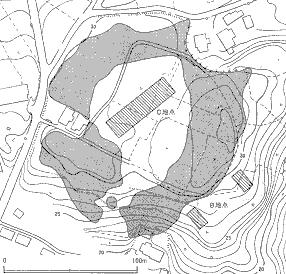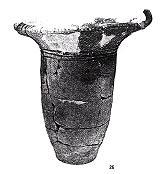|
|
- Confirmation report about the structure
of shellmound out part, 1976 -
NIPPON ROAD PUBLIC CO., LTD. /Tokyo Daiichi
Construction office
Incorporated foundation/Chiba Pref. cultural
assets center |
 South South |
Arayashiki Shellmound/geographic environment
- It is on the tongue state plateau where it
is put between Takashina Branched
Valley
(the west) and Arayashiki Branched
Valley
(the east) that are open to Yoshikawa
River
Valley.
- Height is around 30 m above sea level. Relative
highght with the paddy field face
is 19 m.
- The branched valleys did not receive the
influence of Tokyo Bay. They could obtain
the provisions of life in the back plateau.
Arayashiki Shellmound is the horseshoe-shaped
shellmound with the diameter of about 150
m opening to the south.
There is not ruin in the center of the shellmound.
The survey result of the shellmound part
is as follows.
- Shellfish: (Many) Ibokisago >> clam
>> short-necked clam
- Fish: (Many) herring >> horse mackerel,
mackerel, eel, besides 20 kinds
- Obsidian: Kouzu Island's (20), Hakone (4)
- Pollen: cedar (cold climate) >> hackberry
family, birch family (mild climate)
- Plants: knotweed family, hydrophilic plants
|
 |
 |
 |
The excavation survey of Arayashiki Shellmound
in Chiba City was carried out from 1970 due
to Keiyo Road (a part of highway network
along Tokyo Bay) construction.
The center of the shellmound is the space
with no sites. There are not remains of an
ancient structure generally. This is considered
to be a joint workshop/ meeting place/playground.
Now, this place is used in the playground
of children and dogs /the kite up convention/summer
festival dances . There is a time machine
here. When you come here, you may rejuvenate!
The survey result of the shellmound tells,
the spiral shellfish called "Ibokisago"(I
do not know English name) are overwhelming.
This case is similar to Kasori Shellmound
about 2 km away from Arayashiki Shellmound.
As for the shell in the shellmound, do you
think that clam and short-necked clam are
main? There are few consumption of Ibokisago
now, although the Ibokisago is eaten as the
snack for alcoholic drink. Why are there
a lot of Ibokisago shells?
1. Was the environment suited to the growth
of Ibokisago?
2. Is it easy to manufacture dried shellfish
from spiral shellfish than bivalve?
Considering the size of the shellfish, the
dried shellfish might have been the seasoning.
As they ate boiled food often in Jomon period,
dried shellfish may have been used to add
salty taste to the cooking.
return to top page
 South
South

